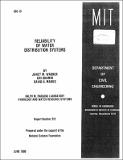Reliability of Water Distribution Systems
Author(s)
Wanger, Janet M.; Shamir, Uri; Marks, David H.
Download16670993.pdf (7.684Mb)
Metadata
Show full item recordAbstract
Reliability of water distribution systems is becoming of increasing concern to water system designers and operators because of the increasing age of many systems and the decreasing availability of public money for water system construction and repair. This report is concerned with identifying, developing, and applying methods for the calculation of probabilistic reliability measures for water distribution systems. Methods are developed for assessing the reliability of water distribution systems for moderately large systems (10 - 50 nodes) with unreliable elements such as: pipe breaks, malfunctioning pumps, and out-of-service transmission and treatment facilities. A comprehensive literature review of reliability methods and measures from a number of fields is presented. The objective of this review is to understand previously used measures and the methods used to calculate them, to integrate measures and methods from different fields, and to suggest other measures and problems to be addressed in a reliability analysis. The water distribution is modeled as a flow-carrying network, with reliable supply and demand nodes and unreliable links. Link failures are assumed to be statistically independent. Analytical methods are identified and/or developed to assess the following measures on these networks: (1) the probability that all demand points in a system are connected to a source; (2) the probability that a given demand point in a system is connected to a source; and by assigning a capacity limit to each link in the system (3) the probability that a system can meet a specified level of flow at each demand point. Two sample systems are analyzed with these methods. A stochastic simulation program is developed which calculates a number of reliability measures for networks with reliable supply and demand nodes, unreliable links, and water storage tanks of finite volume. Link failures are again assumed to be statistically independent. Different probability distributions are postulated for the distributions of (1) time until failure and (2) time until repair of individual elements. Three sample systems are analyzed with this program. Finally, an overview of a general methodology for the reliability assessment of an existing water distribution is presented.
Description
Project was funded by the National Science Foundation by a grant concerning stochastic methods for Water Resources Management, NSF Grant CEE 8408369
Date issued
1986-06Publisher
Cambridge, Mass : Ralph M. Parsons Laboratory, Hydrology and Water Resource Systems, Dept. of Civil Engineering, School of Engineering, Massachusetts Institute of Technology
Other identifiers
312
Series/Report no.
R (Massachusetts Institute of Technology. Department of Civil Engineering) ; 86-18.Report (Ralph M. Parsons Laboratory for Water Resources and Hydrodynamics) ; 312.